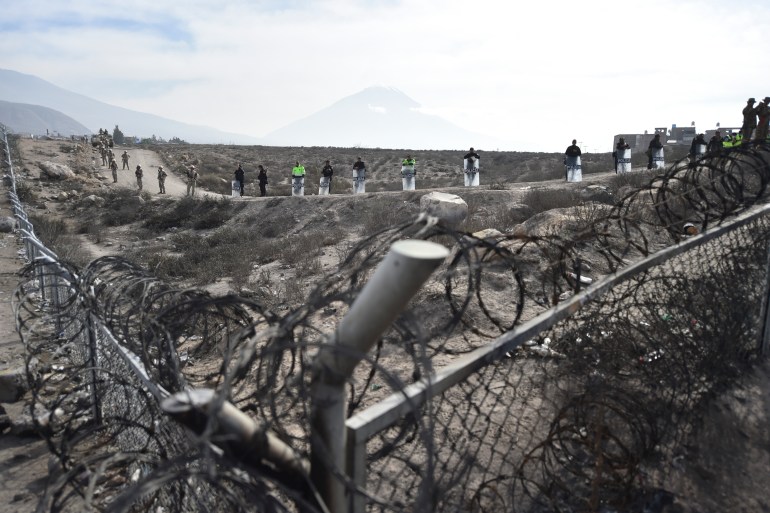Peru roadblocks resume as president urges ‘peace, calm, unity’
Protests reignite in Peru after holiday pause, with many demonstrators demanding removal of new President Dina Boluarte.

Anti-government demonstrations and roadblocks have resumed in Peru after a two-week pause as the South American nation continues to reel from last month’s impeachment, arrest and detention of former President Pedro Castillo.
Peruvian protesters on Wednesday used stones and burning tyres to barricade main routes in the southern regions of Puno, Cusco, Apurimac and Arequipa, as well as in Junin, a department in the centre of the country.
Keep reading
list of 3 itemsPeruvian court upholds 18-month pre-trial detention for Castillo
Peru’s new president reshuffles cabinet as Mexico ties tested
The crowds chanted for the removal of President Dina Boluarte, who took over on December 7 after the country’s opposition-held Congress overwhelmingly voted to remove Castillo.
Castillo, a former rural school teacher and union leader who took office in July 2021, was impeached after he tried to dissolve the legislature and rule by decree – a move widely condemned as an attempted coup.
He was arrested shortly after the impeachment vote and has been ordered to remain in pretrial detention for 18 months on charges of rebellion and conspiracy, which Castillo has denied.
The left-wing leader’s removal followed months of escalating tensions with Peru’s Congress over allegations of corruption. It spurred demonstrations across the country, particularly in rural regions where Castillo garners much of his support.
In addition to Boluarte’s removal, the protesters also are demanding the closure of Congress — which has a high disapproval rate — along with changes to the Constitution and Castillo’s release from prison.
The new government has agreed to bring forward elections set for 2026 to April next year — another key demand of the demonstrators — but many want the vote to happen even sooner.
While the demonstrations died down over the holiday period, representatives of civil groups and unions from 10 historically left-wing regions in southern Peru announced their resumption on Wednesday.
“There are 10 blockades, mainly around Puno,” government spokesman Alberto Otarola told reporters in the capital, Lima, where a crisis centre was set up.
As a precaution, train services between the town of Cusco and the Machu Picchu historical site were suspended indefinitely on Tuesday. Some 2,000 were tourists escorted from the tourist destination. During the first wave of protests, thousands were stranded in the area after transportation was disrupted.

In mid-December, Boluarte’s administration declared a 30-day, nationwide state of emergency, suspending certain civil liberties and authorising the police and military to be deployed in a bid to stop the demonstrations.
Television footage on Wednesday showed police and the army guarding the headquarters of public institutions in areas where protests were announced, including Ayacucho, which has been a centre of the recent unrest.
In a speech from Lima, Boluarte again called for a return to calm.
She blamed the protests for “delays, pain, economic losses” and urged “peace, calm, unity to promote development of the homeland”.
But in the mountainous Apurimac region, protest leader Milan Knezvich said the struggle will continue. “No one will want to talk to her. As long as Mrs Dina Boluarte does not resign, this will continue,” he told Exitosa radio.
On Tuesday, thousands of people marched in Lima and elsewhere demanding “peace and tranquillity”. The country’s human rights ombudsman has said 22 people were killed in protest-related clashes and more than 600 were injured so far.
